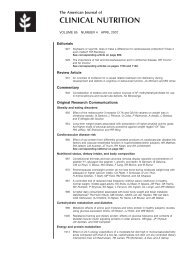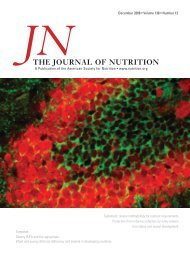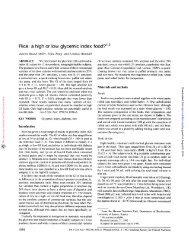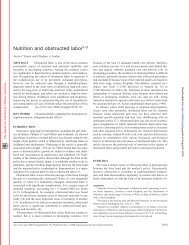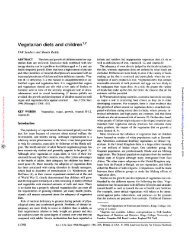Influence of Plane of Nutrition on Body Composition, Organ Size and ...
Influence of Plane of Nutrition on Body Composition, Organ Size and ...
Influence of Plane of Nutrition on Body Composition, Organ Size and ...
Create successful ePaper yourself
Turn your PDF publications into a flip-book with our unique Google optimized e-Paper software.
ENERGY UTILIZATION DURING REALIMENTATION 2531MetabolizableTABLE 5(ME) intakes, live weight gain <strong>and</strong> gain <str<strong>on</strong>g>of</str<strong>on</strong>g> empty body comp<strong>on</strong>ents<str<strong>on</strong>g>of</str<strong>on</strong>g> male <strong>and</strong> female rats during period 2weightbodySexMaleFemaleMaleMaleFemaleFern intakekcal/d55.141.838.942.941.743.424.827.730.728.129.931.614.717.816.119.51.58Livegaing/d4.641.941.754.871.643.47-1.191.864.800.031.484.55-1.861.79-1.251.860.51Emptyweightg/d4.362.581.994.432.413.66-0.761.704.341.262.044.39-1.611.70-0.451.980.41Watergaing/d2.471.151.022.540.921.71-0.521.052.780.500.852.60-1.131.12-0.691.1gaing/d0.670.230.290.800.240.56-0.310.130.62-0.190.160.63-0.270gaing/d1.020.390.560.870.430.680.000.380.870.210.380EnergyaleMaleMaleMaleFemaleFernaleFemaleMaleMaleFemaleFemaleRSDTreatment1HHHHHMMHHMMHHLMMLHHLMMLHMLLMMLLMME'Treatments are designated by a two-letter code. The first letter indicates that the target gain during the initial21-d period was 105 (H), 40 (M) or —25 (L) g. The sec<strong>on</strong>d letter indicates that the target gain during the sec<strong>on</strong>d21-d period was 105 (H), 40 (M) or -25 (L) g.(HH>MH = LH). Percentages <str<strong>on</strong>g>of</str<strong>on</strong>g> emptybody weight gain as protein were 23.4, 19.6<strong>and</strong> 20.0 for HH, MH <strong>and</strong> LH male rats,respectively. This pattern was also evidentfor male rats assigned to the M treatmentduring period 2. Percentages <str<strong>on</strong>g>of</str<strong>on</strong>g> empty bodyweight gain as protein were 28.1, 22.4 <strong>and</strong>21.2 for HM, MM <strong>and</strong> LM male rats. Theseresults suggest that protein gain duringperiod 2 was influenced by protein mass atthe beginning <str<strong>on</strong>g>of</str<strong>on</strong>g> the period. Similar patterns were not observed when similar comparis<strong>on</strong>s were made with female ratsassigned to the H or M treatments duringperiod 2. No c<strong>on</strong>sistent patterns were apparent in males or females for the proporti<strong>on</strong> <str<strong>on</strong>g>of</str<strong>on</strong>g> fat in live weight gain with respectto previous nutriti<strong>on</strong>al treatment.This experiment was designed in such away that there were three groups <str<strong>on</strong>g>of</str<strong>on</strong>g> ratswith the same age but different bodyweights at the beginning <str<strong>on</strong>g>of</str<strong>on</strong>g> period 2 resulting from different levels <str<strong>on</strong>g>of</str<strong>on</strong>g> food intake during period 1. The effect <str<strong>on</strong>g>of</str<strong>on</strong>g> previousnutriti<strong>on</strong>al treatment <strong>on</strong> the efficiency <str<strong>on</strong>g>of</str<strong>on</strong>g>utilizati<strong>on</strong> <str<strong>on</strong>g>of</str<strong>on</strong>g> ME for maintenance or gainwas evaluated by combining treatments according to the level <str<strong>on</strong>g>of</str<strong>on</strong>g> nutriti<strong>on</strong> duringperiod 1 (HH + HM + HL; MH + MM + ML;LH + LM). No evidence <str<strong>on</strong>g>of</str<strong>on</strong>g> significant sex effects was observed in the initial analyses;thus male <strong>and</strong> female rats were both includedin the final regressi<strong>on</strong> analyses (table 6). Efficiencies <str<strong>on</strong>g>of</str<strong>on</strong>g> utilizati<strong>on</strong> <str<strong>on</strong>g>of</str<strong>on</strong>g> ME for gain (b2)were lower (P < 0.05) for rats <str<strong>on</strong>g>of</str<strong>on</strong>g> the Htreatment during period 1 than for those <str<strong>on</strong>g>of</str<strong>on</strong>g>the M or L treatment. Although not statistically compared, maintenance (bilb2) appeared to decrease substantially as previouslevel <str<strong>on</strong>g>of</str<strong>on</strong>g> nutriti<strong>on</strong> decreased. Estimates <str<strong>on</strong>g>of</str<strong>on</strong>g>the metabolizable energy required for energy equilibrium <str<strong>on</strong>g>of</str<strong>on</strong>g> rats from the H, M <strong>and</strong> Lprevious treatment groups were 114, 107<strong>and</strong> 86 kcal/(kg°7s-d), respectively.Weights <str<strong>on</strong>g>of</str<strong>on</strong>g> internal organs obtained atthe end <str<strong>on</strong>g>of</str<strong>on</strong>g> period 2 are shown in table 7. Itis not surprising that organ weights wererelated to body weight. However, whenDownloaded from jn.nutriti<strong>on</strong>.org by guest <strong>on</strong> August 9, 2014



